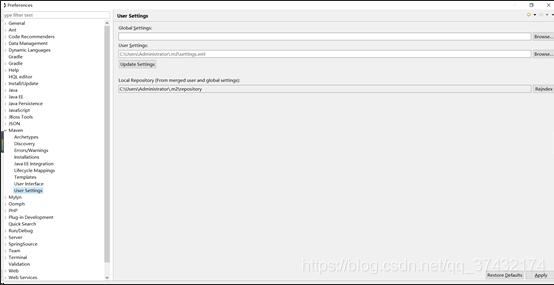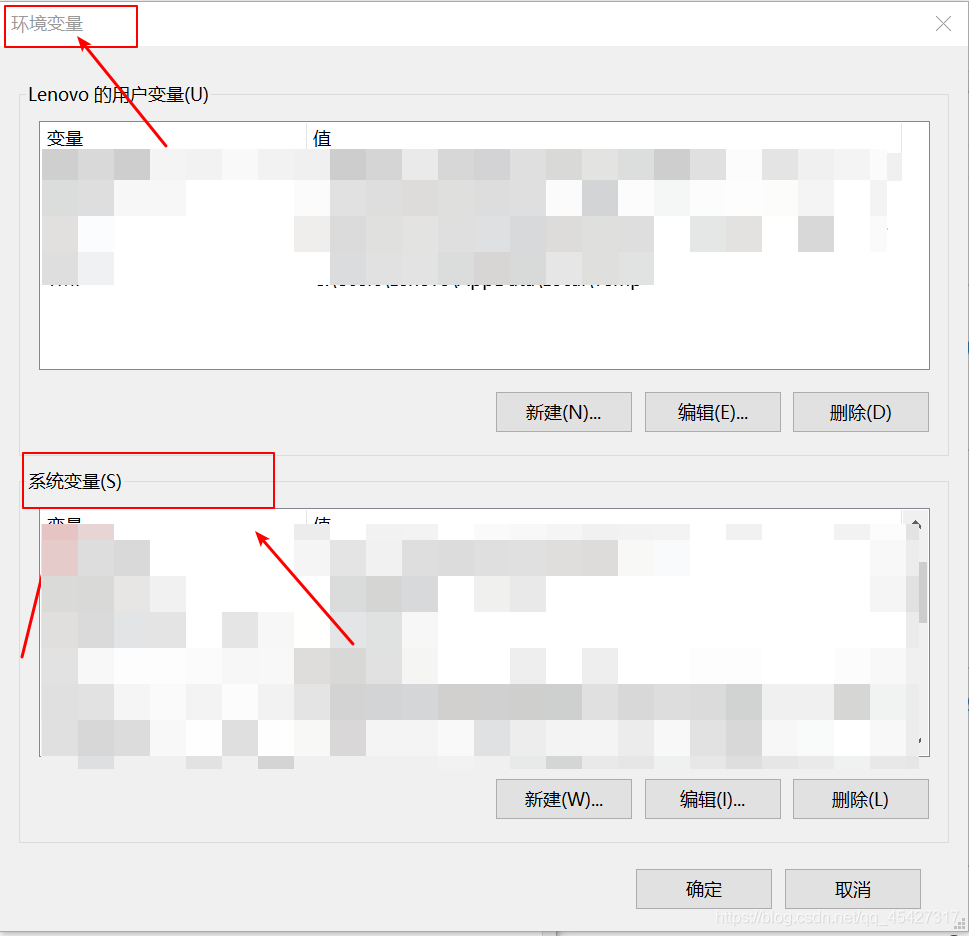导入maven项目各个注解均报错的解决方案
目录
- 导入maven项目各个注解均报错
- 所遇问题
- 解决方案
- 新导入maven项目注解爆红,所有依赖包无法导入
- 经过反复测试终于发现原因所在!!!
- 解决步骤如下
导入maven项目各个注解均报错
所遇问题
导入maven项目各个注解均报错了
思考1:
这个项目使用了springboot;spring是个”大容器”,所有对象的创建和管理都交给了它, (SpringBoot是一个框架,一种全新的编程规范,他的产生简化了框架的使用,所谓简化是指简化了Spring众多框架中所需的大量且繁琐的配置文件,所以 SpringBoot是一个服务于框架的框架,服务范围是简化配置文件。
最明显的特点是,让文件配置变的相当简单、让应用部署变的简单(SpringBoot内置服务器,并装备启动类代码),可以快速开启一个Web容器进行开发。);先去查看springboot是否扫描到这些文件;
结果:查看配置文件XML以及各层的依赖,应该没出错。
思考2:
该导入的包是否成功导入?查看maven依赖树(mvn dependency),并检查依赖版本等是否有用;结果:应该没错,依赖树上显示了加入的jar包。
思考3:
有事问度娘;百度上的方法各异;我并没有成功,也许是我操作或者对它们的理解出了问题吧;决定问大佬,我问了大佬,大佬从事安卓开发多年,所以帮我叫来另一个大佬;在另一个大佬的指点下,
解决方案
我先是去了本地仓库setting.xml下的镜像改为aliyun的镜像;(下图是查找你当前maven项目的本地仓库已经配置文件setting.xml的方法)


我这个是默认生成的,如果没有配置文件setting.xml;就自己新建一个;新建方法很多这里就不介绍了;附上我的setting.xml
<?xml version="1.0" encoding="UTF-8"?>
<!--
Licensed to the Apache Software Foundation (ASF) under one
or more contributor license agreements. See the NOTICE file
distributed with this work for additional information
regarding copyright ownership. The ASF licenses this file
to you under the Apache License, Version 2.0 (the
"License"); you may not use this file except in compliance
with the License. You may obtain a copy of the License at
http://www.apache.org/licenses/LICENSE-2.0
Unless required by applicable law or agreed to in writing,
software distributed under the License is distributed on an
"AS IS" BASIS, WITHOUT WARRANTIES OR CONDITIONS OF ANY
KIND, either express or implied. See the License for the
specific language governing permissions and limitations
under the License.
-->
<!--
| This is the configuration file for Maven. It can be specified at two levels:
|
| 1. User Level. This settings.xml file provides configuration for a single
| user, and is normally provided in
| ${user.home}/.m2/settings.xml.
|
| NOTE: This location can be overridden with the CLI option:
|
| -s /path/to/user/settings.xml
|
| 2. Global Level. This settings.xml file provides configuration for all
| Maven users on a machine (assuming they're all using the
| same Maven installation). It's normally provided in
| ${maven.home}/conf/settings.xml.
|
| NOTE: This location can be overridden with the CLI option:
|
| -gs /path/to/global/settings.xml
|
| The sections in this sample file are intended to give you a running start
| at getting the most out of your Maven installation. Where appropriate, the
| default values (values used when the setting is not specified) are provided.
|
|-->
<settings xmlns="http://maven.apache.org/SETTINGS/1.0.0"
xmlns:xsi="http://www.w3.org/2001/XMLSchema-instance"
xsi:schemaLocation="http://maven.apache.org/SETTINGS/1.0.0 http://maven.apache.org/xsd/settings-1.0.0.xsd">
<!-- localRepository
| The path to the local repository maven will use to store artifacts.
|
| Default: ~/.m2/repository
<localRepository>/path/to/local/repo</localRepository>
-->
<!--<localRepository>C:/Users/Administrator/.m2/repository</localRepository> -->
<localRepository>F:/eclipse_workspace20170314/repository</localRepository>
<!-- interactiveMode
| This will determine whether maven prompts you when it needs input. If set
| to false, maven will use a sensible default value, perhaps based on some
| other setting, for the parameter in question.
|
| Default: true
<interactiveMode>true</interactiveMode>
-->
<!-- offline
| Determines whether maven should attempt to connect to the network when
| executing a build. This will have an effect on artifact downloads,
| artifact deployment, and others.
|
| Default: false
<offline>false</offline>
-->
<!-- pluginGroups
| This is a list of additional group identifiers that will be searched when
| resolving plugins by their prefix, i.e. when invoking a command line like
| "mvn prefix:goal". Maven will automatically add the group identifiers
| "org.apache.maven.plugins" and "org.codehaus.mojo" if these are not
| already contained in the list.
|-->
<pluginGroups>
<!-- pluginGroup
| Specifies a further group identifier to use for plugin lookup.
<pluginGroup>com.your.plugins</pluginGroup>
-->
</pluginGroups>
<!-- proxies
| This is a list of proxies which can be used on this machine to connect to
| the network. Unless otherwise specified (by system property or command-
| line switch), the first proxy specification in this list marked as active
| will be used.
|-->
<proxies>
<!-- proxy
| Specification for one proxy, to be used in connecting to the network.
|
<proxy>
<id>optional</id>
<active>true</active>
<protocol>http</protocol>
<username>proxyuser</username>
<password>proxypass</password>
<host>proxy.host.net</host>
<port>80</port>
<nonProxyHosts>local.net|some.host.com</nonProxyHosts>
</proxy>
-->
</proxies>
<!-- servers
| This is a list of authentication profiles, keyed by the server-id used
| within the system. Authentication profiles can be used whenever maven must
| make a connection to a remote server.
|-->
<servers>
<!-- server
| Specifies the authentication information to use when connecting to a
| particular server, identified by a unique name within the system
| (referred to by the 'id' attribute below).
|
| NOTE: You should either specify username/password OR
| privateKey/passphrase, since these pairings are used together.
|
<server>
<id>deploymentRepo</id>
<username>repouser</username>
<password>repopwd</password>
</server>
-->
<!-- Another sample, using keys to authenticate.
<server>
<id>siteServer</id>
<privateKey>/path/to/private/key</privateKey>
<passphrase>optional; leave empty if not used.</passphrase>
</server>
-->
</servers>
<!-- mirrors
| This is a list of mirrors to be used in downloading artifacts from remote
| repositories.
|
| It works like this: a POM may declare a repository to use in resolving
| certain artifacts. However, this repository may have problems with heavy
| traffic at times, so people have mirrored it to several places.
|
| That repository definition will have a unique id, so we can create a
| mirror reference for that repository, to be used as an alternate download
| site. The mirror site will be the preferred server for that repository.
|-->
<mirrors>
<!-- mirror
| Specifies a repository mirror site to use instead of a given repository.
| The repository that this mirror serves has an ID that matches the
| mirrorOf element of this mirror. IDs are used for inheritance and direct
| lookup purposes, and must be unique across the set of mirrors.
|
<mirror>
<id>mirrorId</id>
<mirrorOf>repositoryId</mirrorOf>
<name>Human Readable Name for this Mirror.</name>
<url>http://my.repository.com/repo/path</url>
</mirror>
-->
<mirror>
<id>nexus-aliyun</id>
<mirrorOf>*</mirrorOf>
<name>Nexus aliyun</name>
<url>http://maven.aliyun.com/nexus/content/groups/public</url>
</mirror>
<!-- profiles
| This is a list of profiles which can be activated in a variety of ways,
| and which can modify the build process. Profiles provided in the
| settings.xml are intended to provide local machine-specific paths and
| repository locations which allow the build to work in the local
| environment.
|
| For example, if you have an integration testing plugin - like cactus -
| that needs to know where your Tomcat instance is installed, you can
| provide a variable here such that the variable is dereferenced during the
| build process to configure the cactus plugin.
|
| As noted above, profiles can be activated in a variety of ways. One
| way - the activeProfiles section of this document (settings.xml) - will be
| discussed later. Another way essentially relies on the detection of a
| system property, either matching a particular value for the property, or
| merely testing its existence. Profiles can also be activated by JDK
| version prefix, where a value of '1.4' might activate a profile when the
| build is executed on a JDK version of '1.4.2_07'. Finally, the list of
| active profiles can be specified directly from the command line.
|
| NOTE: For profiles defined in the settings.xml, you are restricted to
| specifying only artifact repositories, plugin repositories, and
| free-form properties to be used as configuration variables for
| plugins in the POM.
|
|-->
<profiles>
<!-- profile
| Specifies a set of introductions to the build process, to be activated
| using one or more of the mechanisms described above. For inheritance
| purposes, and to activate profiles via <activatedProfiles/> or the
| command line, profiles have to have an ID that is unique.
|
| An encouraged best practice for profile identification is to use a
| consistent naming convention for profiles, such as 'env-dev',
| 'env-test', 'env-production', 'user-jdcasey', 'user-brett', etc. This
| will make it more intuitive to understand what the set of introduced
| profiles is attempting to accomplish, particularly when you only have a
| list of profile id's for debug.
|
| This profile example uses the JDK version to trigger activation, and
| provides a JDK-specific repo.
<profile>
<id>jdk-1.4</id>
<activation>
<jdk>1.4</jdk>
</activation>
<repositories>
<repository>
<id>jdk14</id>
<name>Repository for JDK 1.4 builds</name>
<url>http://www.myhost.com/maven/jdk14</url>
<layout>default</layout>
<snapshotPolicy>always</snapshotPolicy>
</repository>
</repositories>
</profile>
-->
<!--
| Here is another profile, activated by the system property 'target-env'
| with a value of 'dev', which provides a specific path to the Tomcat
| instance. To use this, your plugin configuration might hypothetically
| look like:
|
| ...
| <plugin>
| <groupId>org.myco.myplugins</groupId>
| <artifactId>myplugin</artifactId>
|
| <configuration>
| <tomcatLocation>${tomcatPath}</tomcatLocation>
| </configuration>
| </plugin>
| ...
|
| NOTE: If you just wanted to inject this configuration whenever someone
| set 'target-env' to anything, you could just leave off the
| <value/> inside the activation-property.
|
<profile>
<id>env-dev</id>
<activation>
<property>
<name>target-env</name>
<value>dev</value>
</property>
</activation>
<properties>
<tomcatPath>/path/to/tomcat/instance</tomcatPath>
</properties>
</profile>
-->
</profiles>
<!-- activeProfiles
| List of profiles that are active for all builds.
|
<activeProfiles>
<activeProfile>alwaysActiveProfile</activeProfile>
<activeProfile>anotherAlwaysActiveProfile</activeProfile>
</activeProfiles>
-->
</settings>
如何修改成aliyun镜像:

然后去本地仓库把.lastUpdated为后缀的文件删除了;再重新下载依赖;也就那些jar包,解决了吗?并没有,再试一次?去本地仓库把.lastUpdated为后缀的文件删除了,重新导入maven项目;不成啊。最后,我把本地仓库里的jar全删除了,再重新导入项目,重新下载依赖,就成功了。
原因:本地仓库里存有上一个项目所留下jar包,jar版本不同起了冲突,所以有一些jar无法使用,或者是导入项目后加载依赖时出现了jar包破损。(恳请纠正我,我也是百度并自己理解的出来的原因)
如果查看错误,出现不能被读或者它某jar也许是个zip文件这类错误,就是jdk版本太低,去更换一下项目的jdk环境,选择项目属性进行查看并更改
新导入maven项目注解爆红,所有依赖包无法导入
刚开始做maven项目时,导入网上的一个开源spring boot项目结果整体崩掉,所有注解全部报错,进行下载依赖无法下载,idea中点击无反应,搜了一下午的bug也未彻底解决:

经过反复测试终于发现原因所在!!!
是因为本人电脑系统所致,在配置maven环境变量是无法读取引用路径符号%,导致maven没彻底配置成功,即使cmd输入 mvn -v显示没问题
解决步骤如下
在系统变量配置中配置path变量时使用maven安装的bin目录绝对路径即可!!!


此bug可能仅是部分小伙伴的系统会出现,一定记住谨防采坑!!!
以上为个人经验,希望能给大家一个参考,也希望大家多多支持我们

